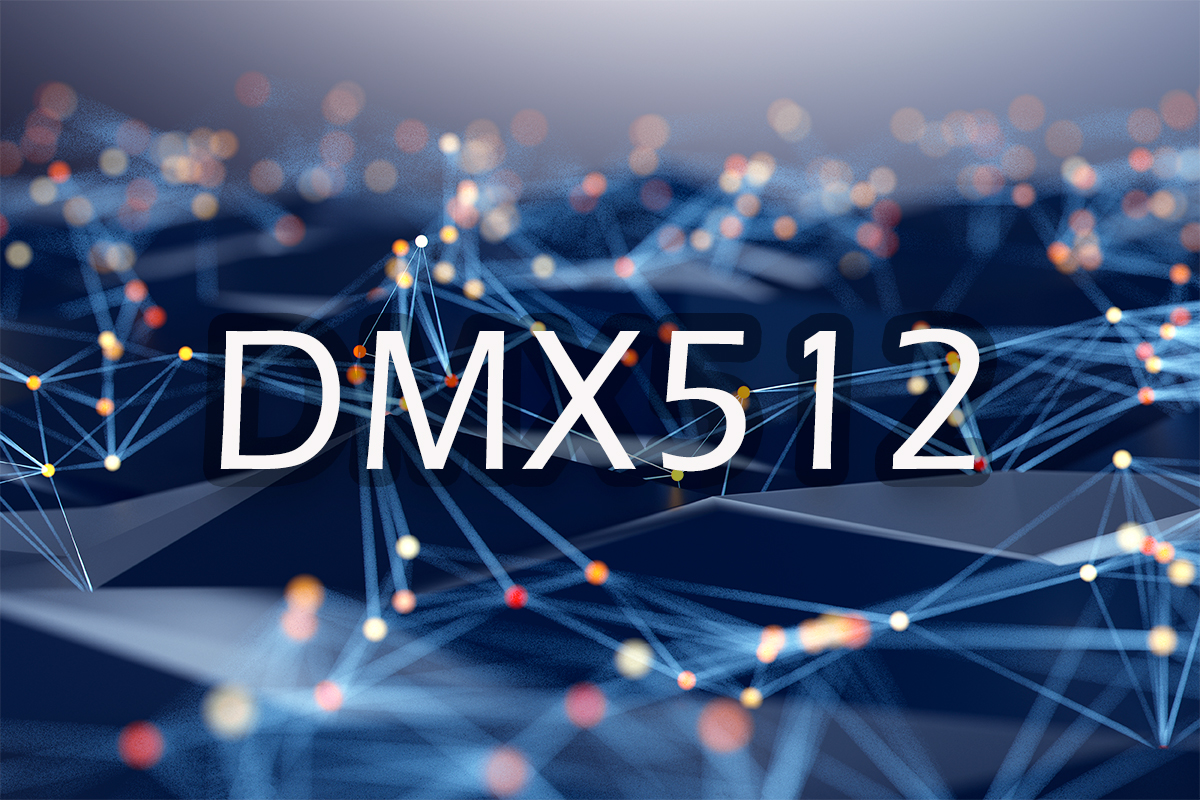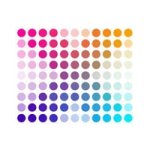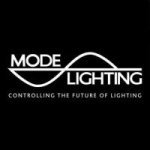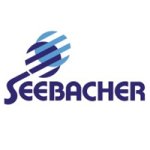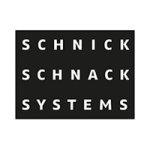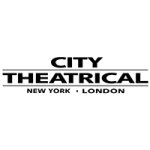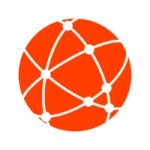Channeling creativity
The
DMX512 protocol is a standardized system used for controlling lighting and special effects equipment in various entertainment and
architectural applications. The acronym DMX stands for Digital MultipleX, which signifies the method of multiplexing digital data for transmission over a single cable. This technique allows multiple devices to share the same communication medium efficiently. The '512' in DMX512 denotes that the protocol supports up to 512 separate control channels. These channels are used to send control commands from a DMX controller (or master device) to various
lighting fixtures and special effects devices. Each control channel within the DMX512 protocol is assigned a unique address ranging from 1 to 512. This addressing scheme enables precise control over individual devices connected to the DMX network. Also referred to as the master device, the DMX controller is responsible for generating control commands and transmitting them over the DMX512 network. It allows users to manipulate lighting and effects parameters programmatically. Every device that receives and responds to DMX control commands is known as a DMX receiver or slave device. These devices, such as lighting fixtures or fog machines, are configured to listen to specific DMX channels corresponding to their assigned addresses. DMX512 is built upon the EIA/TIA-485 standard, also known as RS-485. This standard defines the electrical characteristics of the communication bus, such as voltage levels and signaling, ensuring reliable data transmission.
Features of DMX lighting systems
The combination of versatility, scalability, standardization, ease of control, real-time responsiveness, multimedia integration, and adaptability to technological advancements contributes to the widespread popularity of DMX lighting in various industries and applications. The DMX512 protocol provides a standardized communication method for controlling lighting equipment from different manufacturers. This standardization ensures interoperability between devices from various brands, giving users the flexibility to mix and match fixtures based on their requirements. DMX lighting can be easily controlled using dedicated DMX controllers, software-based lighting consoles, or even custom-built control systems. This ease of control enables lighting designers and operators to create dynamic lighting effects and sequences with relative simplicity. DMX512 communication allows for real-time responsiveness, ensuring that lighting changes are executed instantly and smoothly. This capability is crucial for live events, performances, and installations where timing and synchronization are critical. DMX lighting systems can seamlessly integrate with multimedia technologies such as audio, video, and
motion sensors. This integration enables synchronized and immersive experiences where lighting effects complement other elements of the production or installation. DMX lighting systems offer immense versatility in controlling various aspects of lighting and special effects equipment. Users can precisely manipulate parameters such as color, intensity, movement, and timing, allowing for a wide range of creative possibilities in lighting design. DMX lighting systems can scale from simple setups with a few fixtures to complex installations with hundreds of devices. This scalability makes DMX suitable for a broad spectrum of applications, from small events to large-scale productions and architectural projects. The DMX512 protocol has evolved over the years to accommodate advances in lighting technology, such as
LED luminaires, moving lights, and pixel mapping. This adaptability ensures that DMX remains relevant and capable of supporting cutting-edge lighting innovations.
DMX512 lighting control system
A DMX512 lighting control system encompasses a range of interconnected products designed to facilitate the implementation of lighting solutions utilizing the DMX512 protocol. These products work collaboratively to enable control, management, and customization of architectural and
landscape lighting systems. DMX controllers generate and send DMX control signals to lighting fixtures. These controllers can vary from simple handheld units to sophisticated software-based systems. Remote Device Management (RDM) controllers are an extension of the DMX512 protocol that allows bidirectional communication with compatible fixtures for advanced configuration and monitoring. Controllers that utilize Ethernet networking protocols for communication offer expanded capabilities and flexibility in system design and integration. Lighting consoles are comprehensive control surfaces equipped with faders, buttons, and touchscreens for programming and executing complex lighting cues and sequences.
Network gateways facilitate communication between DMX512 networks and other protocols or networks, such as Art-Net or sACN, enabling interoperability and system expansion. Protocol converters convert between different lighting control protocols, allowing compatibility between fixtures and controllers using different standards. DMX repeaters are used to boost and regenerate DMX signals over long cable runs, preventing signal degradation and ensuring reliable communication with distant fixtures. Control panels are interface panels installed in architectural or landscape settings for manual control of lighting scenes and effects by users or operators. Triggering devices such as sensors or input devices used to trigger specific lighting events or sequences based on environmental conditions or user interactions. Commissioning tools are software applications or hardware devices used for system setup, configuration, and testing during the installation and commissioning phase. This collection of products enables the implementation of sophisticated lighting designs and effects in architectural and landscape environments, leveraging the capabilities of DMX-controlled LED lighting. By harnessing the power of DMX512, designers and operators can unlock the full potential of LED technology to enhance spaces, evoke emotions, and create visually stunning experiences. The versatility and flexibility of DMX512-based
lighting control systems offer endless possibilities for artistic expression and innovation, bridging the gap between visual art and cutting-edge lighting technology.
Illuminating innovation: exploring the fusion of LED technology and DMX
The convergence of LED technology and DMX enables lighting designers, architects, and facility managers to push the boundaries of creativity, efficiency, and functionality in lighting design. From vibrant
architectural lighting installations to immersive entertainment experiences, this synergy continues to redefine the possibilities of lighting in diverse applications, offering both aesthetic appeal and practical benefits. LED technology offers a wide range of color options and dynamic effects that can be precisely controlled using DMX protocols. With DMX, lighting designers have granular control over individual LEDs, allowing them to create intricate color schemes, transitions, and effects to suit any ambiance or mood. This versatility opens up new possibilities for creative expression in architectural, entertainment, and artistic lighting applications. DMX control enables precise coordination and synchronization of multiple LED fixtures, allowing designers to create elaborate lighting setups that seamlessly complement the surrounding environment. Whether illuminating building facades, landscapes, or interior spaces, LED technology combined with DMX offers unparalleled flexibility in lighting design. DMX facilitates centralized control and automation of LED lighting systems, enabling seamless integration with other building management systems, sensors, and
IoT (
Internet of Things) devices. Through DMX programming, lighting scenes and sequences can be pre-programmed, scheduled, and triggered automatically based on time of day, occupancy, or environmental conditions. This level of control enhances both energy efficiency and user experience, providing dynamic and responsive lighting environments tailored to specific needs and preferences. LED fixtures have a longer lifespan and require less maintenance compared to traditional lighting sources, reducing operational costs and downtime. When combined with DMX control, LED lighting systems can be monitored remotely for performance optimization and preventive maintenance, ensuring consistent and reliable operation over time.
From indoor to outdoor: the extensive reach of DMX lighting control
DMX512 lighting control contributes to various lighting applications by providing designers and operators with the tools they need to create dynamic, engaging, and visually stunning lighting environments across a wide range of industries and settings. In theatrical productions, DMX allows lighting designers to create complex lighting cues that synchronize with the action on stage. By controlling the intensity, color, and movement of individual fixtures, designers can enhance the mood, atmosphere, and storytelling of a performance. DMX is widely used in concerts, festivals, and other live events to create dynamic lighting effects that complement the music and engage the audience. Lighting designers can program intricate light shows that sync with the rhythm and energy of the music, enhancing the overall concert experience. In architectural lighting applications, DMX enables designers to illuminate buildings, bridges, and other structures with precision and creativity. By controlling the color, brightness, and patterns of lighting fixtures, designers can enhance the aesthetics of architectural spaces, create visual landmarks, and even convey messages or themes through light. DMX is employed in theme parks and attractions to create immersive and interactive lighting experiences for visitors. Lighting designers can synchronize lighting effects with ride movements, show elements, and audio cues, enhancing the overall theme park experience and creating memorable moments for guests. DMX is a staple in nightclub and bar lighting systems, allowing DJs and lighting operators to create immersive environments that enhance the clubbing experience. Dynamic lighting effects, such as moving lights, strobes, and color changes, can be programmed to synchronize with the music and create an energetic atmosphere on the dance floor. In film and television production, DMX is used to control lighting fixtures on set, allowing cinematographers to achieve the desired look and mood for a scene. By adjusting the intensity,
color temperature, and direction of light sources, filmmakers can create visually stunning compositions that enhance the storytelling and emotion of a film or TV show.
The science of DMX control in LED lighting
DMX lighting control systems work with LED lights by sending digital commands over a network to individual fixtures, allowing for precise control over various parameters such as color, intensity, and effects. DMX operates on a channel-based system. Each channel corresponds to a specific attribute or function of the lighting fixture, such as intensity (dimmer), color, pan, tilt, etc. LED fixtures often have multiple channels to control various parameters like
RGB color mixing, intensity, strobing effects, and more. Each LED light fixture or each LED pixel in a DMX system is assigned a unique address. This address determines which fixture will respond to specific commands sent over the DMX network. LED fixtures can usually be set to different DMX addresses using DIP switches or software configuration. The DMX controller typically connects to the LED fixtures through DMX cables. These cables carry the digital control signals from the controller to the LED fixtures. LED fixtures contain
LED driver circuitry, which regulates the electrical power supplied to the LEDs. In DMX-controlled LED lights, the LED driver is designed to receive and interpret DMX signals to adjust the behavior of the LEDs accordingly. The DMX controller sends digital data packets over the DMX cables to the connected LED fixtures. These packets contain information about the desired settings for each fixture, such as color, intensity, and effects. Within the LED fixture, the LED driver circuitry includes components that interpret the incoming DMX signals. This interpretation involves decoding the digital data packets transmitted over the DMX cables to extract information about the desired settings for the LEDs.
LED drivers are programmed to map specific DMX channels to corresponding parameters of the LED fixture, such as intensity levels, color mixing values (for RGB or RGBW fixtures), strobe effects, or other functionalities. The DMX controller sends DMX signals sequentially to all connected LED fixtures. LED drivers within the fixtures ensure that the LEDs respond in sync with the received signals, enabling coordinated lighting effects across multiple fixtures. Based on the DMX signals received and the channel mapping configured, the LED driver adjusts the electrical current supplied to the LEDs. This control allows for precise manipulation of the LED output, including brightness levels, color mixing, and dynamic effects. In some advanced LED fixtures, there may be a feedback mechanism allowing the LED driver to communicate certain information back to the DMX controller. This feedback can include status updates, error notifications, or confirmation of successful command execution, enhancing system monitoring and control.
Remote Data Management (RDM)
Remote Data Management (RDM) enhances the traditional DMX lighting control protocol by adding bidirectional communication capabilities, enabling more advanced configuration, monitoring, and management of lighting fixtures within a DMX512 network. RDM operates as an extension to the DMX protocol, adding bidirectional communication while maintaining compatibility with existing DMX512 networks. It allows for communication between a DMX controller (or other control devices) and RDM-enabled lighting fixtures, also known as RDM slave devices. Unlike traditional DMX, which is unidirectional (one-way), RDM is a half-duplex bidirectional protocol. This means that communication can occur in both directions, allowing the DMX controller to send commands and receive responses from RDM-enabled devices. RDM packets are inserted between existing DMX512 data packets using an alternate start code (0xCC). These packets contain the necessary information for bidirectional communication between the DMX controller and RDM-enabled devices. Each RDM device on the network is assigned a unique identifier (UID), allowing the DMX controller to address and communicate with specific devices individually. RDM enables several functions. The DMX controller can discover all RDM-enabled devices connected to the network. It allows for the configuration of various parameters of RDM devices, such as addressing, personality settings, and operating modes. The DMX controller can monitor the status and performance of RDM devices, including operational status, signal strength, temperature, and more. RDM facilitates remote management tasks, such as firmware updates and diagnostics, for improved system maintenance. RDM devices cannot initiate communication independently; they can only respond when addressed by the DMX controller. This ensures that RDM-enabled fixtures do not interfere with the standard DMX control of lighting scenes. While RDM enhances DMX functionality, there are limitations to consider. For example, the maximum number of RDM slave devices on a single daisy-chained network is typically limited to 32 due to practical considerations related to signal propagation and network performance.
DMX over Ethernet
In architectural lighting installations, particularly those of medium to large scale, addressing limitations inherent in traditional DMX systems are often overcome by deploying DMX over Ethernet protocols. This approach leverages the high bandwidth and flexibility of Ethernet connections to manage a large number of DMX universes more efficiently over individual Ethernet cables. DMX over Ethernet refers to the transmission of DMX control signals over standard Ethernet networks. Instead of using dedicated DMX cables, lighting control data is encapsulated within Ethernet packets and transmitted over Ethernet infrastructure, such as CAT5e or CAT6 cables. DMX over Ethernet addresses these limitations by allowing for the management of multiple DMX universes over a single Ethernet cable, thereby enabling the control of a much larger number of fixtures. Ethernet connections offer significantly higher bandwidth compared to traditional DMX cables, allowing for the transmission of large amounts of lighting control data more efficiently. This increased bandwidth makes it possible to handle the control requirements of complex lighting installations without the constraints of traditional DMX systems. DMX over Ethernet protocols provide greater flexibility in designing and implementing lighting control systems. They support features such as routing, merging, and distribution of DMX data, allowing for more complex and scalable lighting setups. Several protocols have been developed to facilitate the implementation of DMX over Ethernet networks, with notable examples being Art-Net, sACN (Streaming Architecture of Control Networks), and KiNet. Art-Net is one of the most widely used protocols for DMX over Ethernet. It allows for the transmission of DMX data over standard Ethernet networks and supports the management of multiple DMX universes. Art-Net is commonly used in entertainment and architectural lighting applications. sACN (Streaming Architecture of Control Networks), also known as E1.31, is another protocol designed for transmitting DMX data over Ethernet networks. It is an open standard developed by the Entertainment Services and Technology Association (ESTA) and is widely adopted in the entertainment industry. KiNet is a proprietary protocol developed by Philips Lighting (now
Signify) for DMX over Ethernet applications. It is commonly used with Philips Color Kinetics lighting products and offers features tailored to architectural and dynamic lighting installations.
Wireless DMX
Wireless DMX refers to the technology that replaces the physical connections, typically cables, between a master DMX controller and slave lighting fixtures with wireless radio frequency (RF) links. In traditional DMX setups, communication between the controller and fixtures occurs through wired connections, which may limit flexibility and pose challenges in certain setups. Wireless DMX eliminates the need for these physical connections by transmitting DMX control signals wirelessly. Instead of using physical cables to transmit control signals, wireless DMX systems employ RF communication links. These links utilize radio frequency waves to transmit data between the master and slave devices without the need for physical connections. A wireless DMX system typically consists of a transmitter unit connected to the master DMX controller and one or more receiver units connected to the slave lighting fixtures. The transmitter unit converts the DMX control signals into wireless RF signals for transmission, while the receiver units capture these signals and convert them back into DMX data for the lighting fixtures. Wireless DMX systems operate within specific frequency bands allocated for RF communication. Common frequency bands used for wireless DMX include 2.4 GHz and 5 GHz bands, which are widely used for wireless communication and are less susceptible to interference from other devices. The range and coverage of wireless DMX systems depend on factors such as the transmission power of the devices, environmental conditions, and potential obstructions between the transmitter and receiver units. Manufacturers typically specify the effective range of their wireless DMX systems under optimal conditions. Wireless DMX systems must adhere to industry standards to ensure compatibility between different manufacturers' products. Some common wireless DMX standards include W-DMX (Wireless DMX) and CRMX (Cognitive Radio Multiplexer), which define protocols and specifications for wireless DMX communication.
DMX controller
In a DMX network, the master controller serves as the central control unit that manages and coordinates all the lighting fixtures and devices connected to the network. The master controller is responsible for sending and receiving digital signals that control the behavior and output of each individual lighting fixture. DMX controllers encompass a range of devices and software solutions designed to control lighting fixtures via DMX signals. Basic DMX controllers are are typically standalone devices with basic functionality. They often feature physical faders, buttons, and knobs for manual control of lighting parameters. Basic DMX controllers are suitable for small-scale applications or setups where simplicity is preferred. Software-based DMX controllers run on computers or mobile devices and interface with external hardware or USB-DMX interfaces. They offer advanced functionality and flexibility, allowing users to create and program complex lighting sequences, cues, and effects. Software-based controllers are often used in professional lighting environments, such as theaters, concerts, and events. Hardware DMX consoles are dedicated standalone devices designed specifically for lighting control. They come in various sizes and configurations, ranging from compact units suitable for small productions to large consoles with extensive control capabilities. Hardware consoles typically feature physical controls such as faders, buttons, touchscreens, and display screens for intuitive operation. Modular DMX controllers consist of separate components, such as fader wings, touchscreens, and control modules, that can be interconnected to create customized control setups. They offer scalability and flexibility, allowing users to expand their control capabilities as needed. Wireless DMX controllers use wireless RF (radio frequency) communication to transmit DMX signals to lighting fixtures. Wireless DMX controllers are commonly used in temporary or portable lighting applications, such as events, architectural lighting, and film production. DMX software interfaces are software applications that run on computers or mobile devices and provide a graphical user interface for lighting control. They often work in conjunction with external DMX interfaces or USB-DMX dongles to send DMX signals to lighting fixtures.
DMX-controlled LED lights
DMX-controlled LED lights offer versatility and flexibility in lighting applications, and they come in various types tailored to different purposes and environments. RGB LED fixtures contain red, green, and blue LEDs within a single assembly. They allow for individual control of each color channel, enabling the creation of a wide range of colors by mixing different intensities of red, green, and blue light. RGB LED lights are popular for creating dynamic and colorful lighting effects in entertainment venues, architectural lighting, and stage productions. RGBW LED lights include an additional white LED alongside the red, green, and blue LEDs. The addition of the white LED allows for better color mixing and the creation of pastel and desaturated colors, as well as pure
white light. RGBW fixtures are commonly used in applications where accurate
color rendering and adjustable color temperature are important, such as film and television production, photography studios, and retail displays.
Tunable white LED lights feature separate warm white and cool white LEDs. They allow for dynamic adjustment of color temperature along the black body curve from, for example, warm (2700K) to cool (6500K) white light. Single-color LED fixtures contain LEDs of a single color, such as white, warm white, cool white, red, green, or blue. They are often used for functional lighting purposes where color mixing is not required, such as general illumination, accent lighting, and task lighting.
Pixel mapping LED lights feature multiple individual LEDs arranged in a matrix or grid pattern. Each LED pixel can be individually controlled to display colors, patterns, and animations, allowing for intricate visual effects and dynamic lighting displays. Pixel mapping lights are commonly used in stage productions, concerts, nightclubs, and architectural lighting installations to create captivating and immersive lighting designs.
